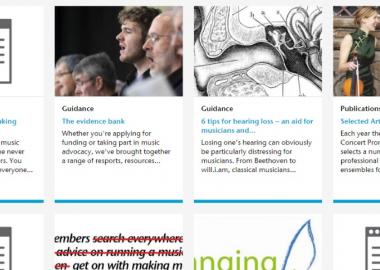Losing your hearing can be particularly distressing for musicians. From Beethoven to will.i.am, classical musicians to pop stars young and old, many people are affected by damage to their hearing, some of which can be caused by musical activities. For example, while ‘safe’ hearing levels are around 60 decibels (about conversation level) an average symphony orchestra might perform at around 120 decibels. Being exposed to more than 89 decibels for more than 5 hours a week will induce hearing damage over time; protection against damage and prevention is vital.
Whether you are hard of hearing, looking to protect your hearing for the future or trying to ensure none of your group members come to harm, we have gathered top tips on how to get the best from your auricles.
1. Be aware and make others aware!
Have a hearing test to check the level of your hearing and repeat annually to detect any changes. If you notice any buzzing, ringing or anything else unusual, such as turning up the TV more and more revisit your audiologist. After a performance or rehearsal be sure give your ears a rest from loud sounds (any) where possible. Encourage your group members to do the same.
You can check your hearing and find out more information on hearing loss on the Action on Hearing Loss website: www.actiononhearingloss.org.uk.
2. Speak to your Musical Director and/ or group
Don’t suffer in silence.
If your lack of hearing is affecting how you play or sing, make sure you speak to someone. They might think about positioning you personally in a different place, moving your whole section to a less exposed position (for example if you are sat in front of brass players), placing greater space between you and other players (for example, if you are a horn player), rehearsing in a larger space or about having a non-traditional set up.
It could be a question of rehearsing below the marked dynamic or avoiding very loud repertoire. You might find it useful to have a few more rehearsals away from the brass or percussion players to minimise damage and allow your hearing to recover.
Your musical director and group committee should be aware of safe levels and how to limit damage to hearing, particularly in a loud instrumental group. If they aren’t yet aware, bring this guidance to their attention and ask them to read it.
Another great document forms part of the BBC’s ‘Musician’s guide to noice and hearing - toolkit for managers’ it contains a lot of useful guidance on what they/ you can do to understand and work safely with sound.
3. Use ear plugs
There is a wide variety of personal hearing protection devices on the market. Basic ones just cancel out sound, but attenuated ear plugs cancel the damaging frequencies allowing you to still hear the music. The idea is not to inhibit your ability to hear music, but to protect your cochlear from the damaging frequencies. We hear with our brains, not our ears – wear both of your earplugs all of the time, even if the noise is coming from one side only.
Google ‘attenuated ear plugs’ to explore the options, with ‘off-the-peg’ ear plugs available and custom fit ones to suit all budgets. Making Music members get disounted rates from market leader ACS on their custom and universial attenuated products.
4. Ask your group to invest in sound barriers
Personal or larger, group acoustic screens protect hearing by reflecting or absorbing sound. These are often used by professional musicians and can be quite expensive. You may like to start a fundraising project if this is something that is essential to your group; it is a good thing to fundraise for as it is a tangible object that people can see the benefit from. Easier (cheaper!) things include foam, curtains or drapes in your venue to help reduce noise levels.
There is a lot of information out there on safe levels and how to achieve them in music. For an easy to follow start try Sound Advice.
5. Adjust your Hearing Aids
Working with hearing aids when you are playing or listening to music can be a case of trial and error. There is a lot to get used to and some people find that they can actually hear music better without their hearing aid in, as standard aids often cannot deal with the complexities and varying frequencies of music. There are things that you might be able do to the settings if yours doesn’t have a music program:
- Extend the frequency
- Disable the frequency manager
- Disable the noise reduction
You can find out more about hearing aids and hearing loss from www.hearinglink.org.
6. Changing it up
Finally, don’t be afraid to try something new! Everyone starts to lose the ability to hear higher frequencies once they pass about 20 years old. Different genres often operate at different frequencies – try out a new type of music that you may be able to hear more clearly.
Play Safe Now, Hear Tomorrow
This page provides advice on protecting your hearing together with a collection of videos and resources for understanding how the ear works to finding out your safe exposure time with and without earplugs. Access further resources from ACS Custom
We hope you find this Making Music resource useful. If you have any comments or suggestions about the guidance please contact us. Whilst every effort is made to ensure that the content of this guidance is accurate and up to date, Making Music do not warrant, nor accept any liability or responsibility for the completeness or accuracy of the content, or for any loss which may arise from reliance on the information contained in it.










